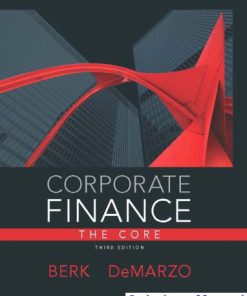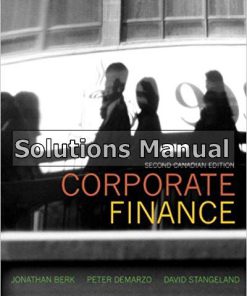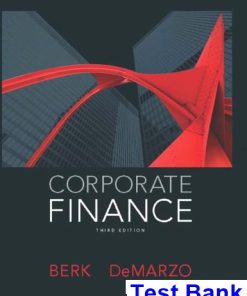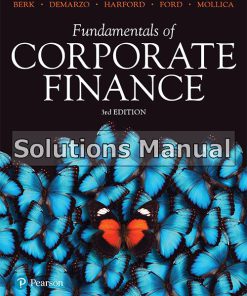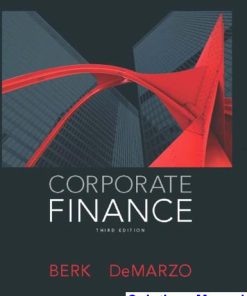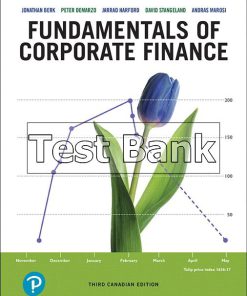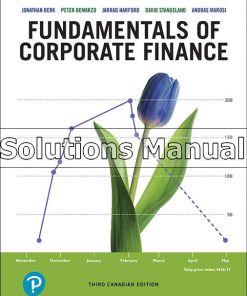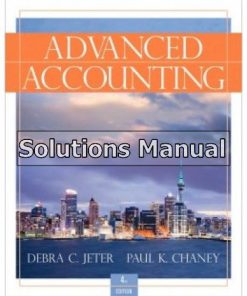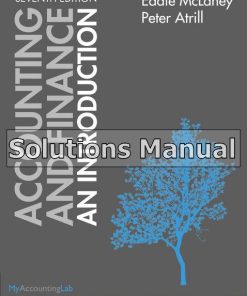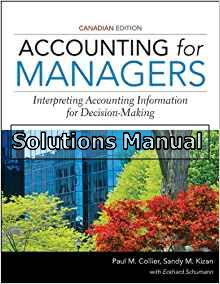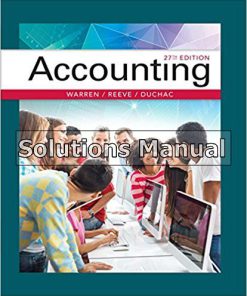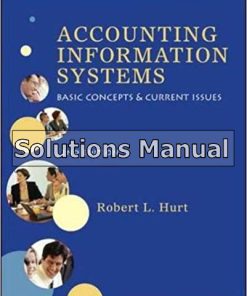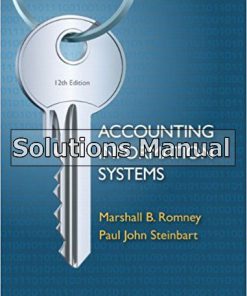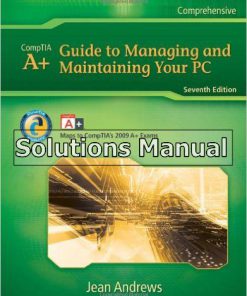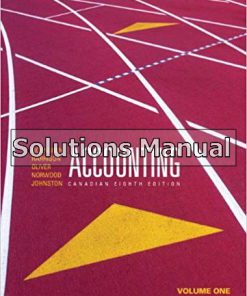Corporate Finance Canadian 3rd Edition Berk Solutions Manual
$50.00 Original price was: $50.00.$26.50Current price is: $26.50.
Corporate Finance Canadian 3rd Edition Berk Solutions Manual.
This is completed downloadable of Corporate Finance Canadian 3rd Edition Berk Solutions Manual
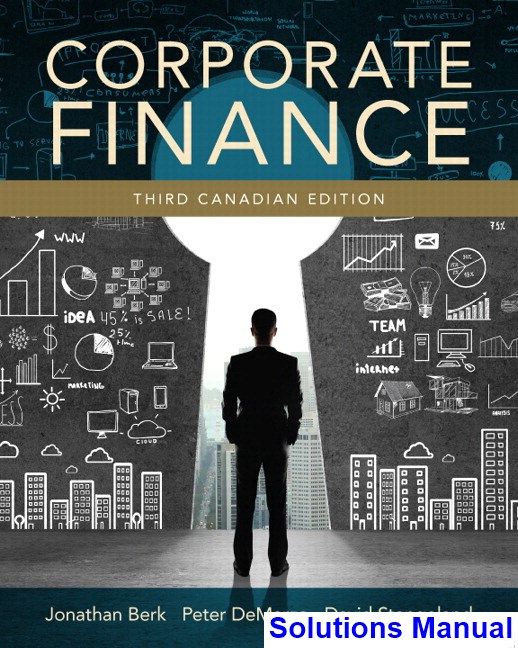
Product Details:
- ISBN-10 : 0133055299
- ISBN-13 : 978-0133055290
- Author: Jonathan Berk (Author), Peter DeMarzo (Author), David Stangeland (Author)
With a consistency in presentation and an innovative set of learning aids, Corporate Finance, Third Canadian Edition, simultaneously meets the needs of both future financial managers and non-financial managers. This textbook truly shows every student how to “think finance.”
Table of Content:
PART I Introduction Chapter 1 The Corporation 1.1 The Four Types of Firms Sole Proprietorships Partnerships Interview with David Viniar Limited Liability Companies Corporations Tax Implications for Corporate Entities 1.2 Ownership Versus Control of Corporations The Corporate Management Team Ownership and Control of Corporations Shareholder Activism and Voting Rights 1.3 The Stock Market The Largest Stock Markets NYSE NASDAQ Summary Key Terms Further Reading Problems Chapter 2 Introduction to Financial Statement Analysis 2.1 The Disclosure of Financial Information Preparation of Financial Statements International Financial Reporting Standards Types of Financial Statements 2.2 The Balance Sheet Assets Liabilities Stockholders' Equity Balance Sheet Analysis 2.3 The Income Statement Earnings Calculations Income Statement Analysis Common Mistake Mismatched Ratios 2.4 The Statement of Cash Flows Operating Activity Investment Activity Financing Activity 2.5 Other Financial Statement Information Interview with Sue Frieden Management Discussion and Analysis Statement of Stockholders' Equity Notes to the Financial Statements 2.6 Accounting Manipulation Enron World Com Sarbanes-Oxley Act Summary Key Terms Further Reading Problems Data Case Chapter 3 Arbitrage and Financial Decision Making 3.1 Valuing Costs and Benefits Using Market Prices to Determine Cash Values When Competitive Market Prices Are Not Available 3.2 Interest Rates and the Time Value of Money The Time Value of Money The Interest Rate: An Exchange Rate Across Time 3.3 Present Value and the NVP Decision Rule Net Present Value The NVP Decision Rule NVP and Individual Preferences 3.4 Arbitrage and the Law of One Price An Old Joke Arbitrage Law of One Price 3.5 No-Arbitrage and Security Prices Valuing a Security Determining the No-Arbitrage Price NASDAQ SOES Bandits Determining the Interest Rate from Bond Prices The NVP of Trading Securities Valuing a Portfolio Stock Index Arbitrage 3.6 The Price of Risk Risky versus Risk-free Cash Flows Risk Aversion and Risk Premium The No-Arbitrage Price of a Risky Security Risk Premiums Depend on Risk Risk is Relative to the Overall Market Risk, Return, and Market Prices 3.7 Arbitrage with Transactions Costs Summary Key Terms Further Reading Problems PART II Tools Chapter 4 The Time Value of Money 4.1 The Timeline 4.2 The Three Rules of Time Travel Comparing and Combining Values Moving Cash Flows Forward in Time Moving Cash Flows Back in Time Applying the Rules of Time Travel 4.3 The Power of Compounding: An Application 4.4 Valuing a Stream of Cash Flows 4.5 The Net Present Value of a Stream of Cash Flows 4.6 Perpetuities, Annuities, and Other Special Cases Perpetuities Historical Examples of Perpetuities Common Mistake Discounting One Too Many Times Annuities Growing Cash Flows 4.7 Solving Problems with a Spreadsheet Program 4.8 Solving for Variables Other Than Present Value or Future Value Solving for the Cash Flows Internal Rate of Return Solving for the Number of Periods Common Mistake Excel's NVP and IRR Functions Rule of 72 Summary Key Terms Further Reading Problems Data Case Chapter 5 Interest Rates 5.1 Interest Rate Quotes and Adjustments The Effective Annual Rate Adjusting the Discount Rate to Different Time Periods Annual Percentage Rates Application: Discount Rates and Loans 5.2 The Determinants of Interest Rates Inflation and Real Versus Nominal Rates Investment and Interest Rate Policy The Yield Curve and Discount Rates Common Mistake Using the Annuity Formula When Discount Rates Vary The Yield Curve and the Economy 5.3 Risk and Taxes Risk and Interest Rates After-Tax Interest Rates 5.4 The Opportunity Cost of Capital Summary Key Terms Further Reading Problems Chapter 6 Investment Decision Rules 6.1 NVP and Stand-Alone Projects NVP Rule Measuring Sensitivity with IRR Alternative Rule versus NVP Rule 6.2 Alternative Decision Rules The Payback Rule The Internal Rate of Return Rule Economic Profit or EVA Interview with Joel M. Stern Why Do Rules Other than the NVP Rule Persist? 6.3 Mutually Exclusive Investment Opportunities Differences in Scale Timing of the Cash Flows Incremental IRR Rule 6.4 Project Selection with Resource Constraints Evaluation of Projects with Different Resource Requirements Profitability Index Shortcomings of the Profitability Index Summary Key Terms Further Reading Problems Data Case PART III Basic Valuation Chapter 7 Fundamentals of Capital Budgeting 7.1 Forecasting Earnings Revenue and Cost Estimates Interview with Dick Grannis Incremental Earnings Forecast Indirect Effects on Incremental Earnings The Opportunity Cost of an Idle Asset Sunk Costs and Incremental Earnings Common Mistake The Opportunity of an Idle Asset Real-World Complexities The Sunk Cost Fallacy 7.2 Determining Free Cash Flow and NVP Calculating the Free Cash Flow from Earnings Calculating Free Cash Flow Directly Calculating the NVP Choosing Among Alternatives Further Adjustments to Free Cash Flow 7.3 Analyzing the Project Break-Even Analysis Sensitivity Analysis Scenario Analysis Summary Key Terms Further Reading Problems Data Case Chapter 8 Valuing Bonds 8.1 Bond Cash Flows, Prices, and Yields Bond Terminology Zero-Coupon Bonds Coupon Bonds 8.2 Dynamic Behavior of Bond Prices Discounts and Premiums Time and Bond Prices Clean and Dirty Prices for Coupon Bonds Interest Rate Changes and Bond Prices 8.3 The Yield Curve and Bond Arbitrage Replicating a Coupon Bond Valuing a Coupon Bond Using Zero-Coupon Yields Coupon Bond Yields Treasury Yield Curves 8.4 Corporate Bonds Corporate Bond Yields Interview with Lisa Black Bond Ratings Corporate Yield Curves Summary Key Terms Further Reading Problems Data Case Chapter 9 Valuing Stocks 9.1 Stock Prices, Returns, and the Investment Horizon A One-Year Investor Dividend Yields, Capital Gains, and Total Returns A Multiyear Investor 9.2 The Dividend-Discount Model Constant Dividend Growth Dividends Versus Investment and Growth Changing Growth Rates Interview with Marilyn Fedak Limitations of the Dividend-Discount Model John Burr Williams' Theory of Investment Value 9.3 Total Payout and Free Cash Flow Valuation Models Share Repurchases and the Total Payout Model The Discounted Free Cash Flow Model 9.4 Valuation Based on Comparable Firms Valuation Multiples Limitations of Multiples Comparison with Discounted Cash Flow Methods Stock Valuation Techniques: The Final Word 9.5 Information, Competition, and Stock Prices Information in Stock Prices Competition and Efficient Markets Lessons for Investors and Corporate Managers The Efficient Markets Hypothesis Versus No Arbitrage Summary Key Terms Further Reading Problems Data Case PART IV Risk and Return Chapter 10 Capital Markets and the Pricing of Risk 10.1 A First Look at Risk and Return 10.2 Common Measures of Risk and Return Probability Distributions Expected Return Variance and Standard Deviation 10.3 Historical Returns of Stocks and Bonds Computing Historical Returns Average Annual Returns The Variance and Volatility of Returns Using Past Returns to Predict the Future: Estimation Error Arithmetic Average Returns Versus Compound Annual Returns 10.4 The Historical Tradeoff between Risk and Return The Returns of Large Portfolios The Returns of Individual Stocks 10.5 Common Versus Independent Risk 10.6 Diversification in Stock Portfolios Firm-Specific Versus Systematic Risk No Arbitrage and the Risk Premium Common Mistake A Fallacy of Long-Run Diversification 10.7 Estimating the Expected Return Measuring Systematic Risk Estimating the Risk Premium 10.8 Risk and the Cost of Capital 10.9 Capital Market Efficiency Notions of Efficiency Empirical Evidence on Capital Market Competition Interview with Randall Lert Summary Key Terms Further Reading Problems Data Case Chapter 11 Optimal Portfolio Choice 11.1 The Expected Return of a Portfolio 11.2 The Volatility of a Two-Stock Portfolio Combining Risks Determining Covariance and Correlation Computing the Variance, Covariance and Correlation in Microsoft Excel Computing a Portfolio's Variance and Volatility 11.3 The Volatility of a Large Portfolio Diversification with an Equally Weighted Portfolio of Many Stocks Diversification with General Portfolios 11.4 Risk Versus Return: Choosing an Efficient Portfolio Efficient Portfolios with Two Stocks The Effect of Correlation Short Sales The Mechanics of a Short Sale Risk versus Return: Many Stocks 11.5 Risk-Free Saving and Borrowing Investing in Risk-Free Securities Borrowing and Buying Stocks on Margin Identifying the Tangent Portfolio 11.6 The Efficient Portfolio and the Cost of Capital How to Improve a Portfolio: Beta and the Required Return Expected Returns and the Efficient Portfolio Cost of Capital Nobel Prizes Harry Markowitz and James Tobin Interview with Jonathan Clements Summary Key Terms Further Reading Problems Data Case Chapter 12 The Capital Asset Pricing Model 12.1 The Efficiency of the Market Portfolio The CAPM Assumptions Security Demand Must Equal Supply Optimal Investing: The Capital Market Line 12.2 Determining the Risk Premium Market Risk and Beta The Security Market Line Alpha Summary of the Capital Asset Pricing Model 12.3 The Market Portfolio Value-Weighted Portfolios Common Stock Market Indexes Interview With John Bogle Index Funds 12.4 Determining Beta Estimating Beta from Historical Returns Why Not Estimate Expected Returns Directly? Using Linear Regression 12.5 Extending the CAPM Investor Information and Rational Expectations 12.6 The CAPM in Practice Forecasting Beta The Security Market Line Evidence Regarding the CAPM Nobel Prize William Sharpe on the CAPM The Bottom Line on the CAPM Summary Key Terms Further Reading Problems Data Case Chapter 13 Alternative Models of Systematic Risk 13.1 The Efficiency of the Market Portfolio Market Capitalization Past Returns 13.2 Implication of Positive Alphas Proxy Error Non-tradeable Wealth Common Mistake Investing in Own Company Stock 13.3 Multifactor Models of Risk Constructing the Efficient Portfolio Building a Multifactor Model Selecting the Portfolios Interview with Rex A. Sinquefield Calculating the Cost of Capital Using the Fama-French-Carhart Factor Specification 13.4 Characteristic Variable Models of Expected Returns 13.5 Methods Used in Practice Summary Key Terms Further Reading Problems PART V Capital Structure Chapter 14 Capital Structure in a Perfect Market 14.1 Equity Versus Debt Financing Financing a Firm with Equity Financing a Firm with Debt and Equity Effect of Leverage on Risk and Return 14.2 Modigliani-Miller I: Leverage, Arbitrage, and Firm Value MM and the Law of One Price MM and the Real World Homemade Lemonade The Market Value Balance Sheet Application: A Leveraged Recapitalization 14.3 Modifliani -Miller II: Leverage, Risk, and the Cost of Capital Leverage and the Equity Cost of Capital Capital Budgeting and the Weighted Average Cost of Capital Common Mistake Is Debt Better Than Equity? Levered and Unlevered Betas Cash and Net Debt Microsoft's Dividend, Cash, and Beta 14.4 Capital Structure Fallacies Leverage and Earnings per Share Equity and Dilution 14.5 MM: Beyond the Propositions Nobel Prize Franco Modigliani and Merton Miller Summary Key Terms Further Reading Problems Data Case Chapter 15 Debt and Taxes 15.1 The Interest Tax Deduction 15.2 Valuing the Interest Tax Shield The Interest Tax Shield and Firm Value The Interest Tax Shield with Permanent Debt Pizza and Taxes The Weighted Average Cost of Capital with Taxes 15.3 Recapitalizing to Capture the Tax Shield The Tax Benefit The Share Repurchase No Arbitrage Pricing Analyzing the Recap: The Market Value Balance Sheet 15.4 Personal Taxes Including Personal Taxes in the Interest Tax Shield Valuing the Interest Tax Shield with Personal Taxes Determining the Actual Tax Advantage of Debt Cutting the Dividend Tax Rate 15.5 Optimal Capital Structure with Taxes Do Firms Prefer Debt? Limits to the Tax Benefit of Debt Growth and Debt Other Tax Shields The Low Leverage Puzzle Employee Stock Options Summary Key Terms Further Reading Problems Data Case Chapter 16 Financial Distress, Managerial Incentives, and Information 16.1 Default and Bankruptcy in a Perfect Market Armin Industries: Leverage and the Risk of Default Bankruptcy and Capital Structure 16.2 The Cost of Bankruptcy and Financial Distress The Bankruptcy Code Direct Costs of Bankruptcy Indirect Costs of Financial Distress 16.3 Financial Distress Costs and Firm Values Armin Industries: The Impact of Financial Distress Costs Who Pays for Financial Distress Costs? 16.4 Optimal Capital Structure: The Tradeoff Theory Determinants of the Present Value of Distress Costs Optimal Leverage 16.5 Exploiting Debt Holders: The Agency Costs of Leverage Over-investment Under-investment Cashing Out Agency Costs and the Value of Leverage Debt Maturity and Covenants 16.6 Motivating Managers: The Agency Benefits of Leverage Concentration of Ownership Reduction of Wasteful Investment Excessive Perks and Corporate Scandals Leverage and Commitment 16.7 Agency Costs and the Tradeoff Theory The Optimal Debt Level Debt Levels in Practice 16.8 Asymmetrical Information and Capital Structure Leverage as a Credible Signal Issuing Equity and Adverse Selection Nobel Prize The 2001 Nobel Prize in Economics Implications for Equity Issuance Implications for Capital Structure 16.9 Capital Structure: The Bottom Line Summary Key Terms Further Reading Problems Data Case Chapter 17 Payout Policy 17.1 Distributions to Shareholders Dividends Share Repurchases 17.2 Comparison of Dividends and Share Repurchases Alternative Policy 1: Pay Dividend with Excess Cash Alternative Policy 2: Share Repurchase (No Dividend) Common Mistake Repurchases and the Supply of Shares Alternative Policy 3: High Dividend (Equity Issue) Modigliani-Miller and the Dividend Policy Irrelevance Common Mistake The Bird in Hand Fallacy Dividend Policy with Perfect Capital Markets 17.3 The Tax Disadvantage of Dividends Taxes on Dividends and Capital Gains Optimal Dividend Policy with Taxes 17.4 Dividend Capture and Tax Clienteles The Effective Dividend Tax Rate Tax Differences Across Investors Clientele Effects 17.5 Payout Versus Retention of Cash Retaining Cash with Perfect Capital Markets Taxes and Cash Retention Adjusting for Investor Taxes Issuance and Agency Costs 17.6 Signaling with Payout Policy Dividend Smoothing Dividend Signaling Royal and SunAlliance's Dividend Cut Signaling and Share Repurchases 17.7 Stock Dividends, Splits, and Spin-offs Stock Dividends and Splits Berkshire Hathaway's A & B Shares Spin-offs Summary Key Terms Further Reading Problems Data Case PART VI Valuation Chapter 18 Capital Budgeting and Valuation with Leverage 18.1 Overview 18.2 The Weighted Average Cost of Capital Method Using the WACC to Value a Project Summary of the WACC Method Implementing a Constant Debt-Equity Ratio 18.3 The Adjusted present Value Method The Unlevered Value of the Project Valuing the Interest Tax Shield Summary of the APV Method 18.4 The Flow-to-Equity Method Calculating the Free Cash Flow to Equity Valuing Equity Cash Flows Summary of the Flow-to-Equity Method What Counts as "Debt"? 18.5 Project-Based Costs of Capital Estimating the Unlevered Cost of Capital Project Leverage and the Equity Cost of Capital Determining the Incremental Leverage of a Project Common Mistake Re-levering the WACC 18.6 APV with Other Leverage Policies Constant Interest Coverage Ratio Predetermined Debt Levels A Comparison of Methods 18.7 Other Effects of Financing Issuance and Other Financing Costs Airline Loan Guarantees after September 11, 2001 Security Mispricing Financial Distress and Agency Costs 18.8 Advanced Topics in Capital Budgeting Periodically Adjusted Debt Leverage and the Cost of Capital The WACC or FTE Method with Changing Leverage Personal Taxes Summary Key Terms Further Reading Problems Data Case Chapter 19 Case Study: Valuation and Financial Modeling 19.1 Valuation Using Comparables 19.2 The Business Plan Operational Improvements Capital Expenditures: A Needed Expansion Working Capital Management Capital Structure Changes: Levering Up 19.3 Building the financial Model Forecasting Earnings Working Capital Requirements Forecasting Free Cash Flow The balance Sheet and Statement of Cash Flows (Optional) 19.4 Estimating the Cost of Capital CAPM-Based Estimation Unlevering Beta Ideko's Unlevered Cost of Capital 19.5 Valuing the Investment The Multiples Approach to Continuation Value The Discounted Cash Flow Approach to Continuation Value Common Mistake Continuation Values and Long-Run Growth APV Valuation of Ideko Equity Common Mistake Missing Assets or Liabilities A Reality Check IRR and Cash Multiples 19.6 Sensitivity Analysis Summary Key Terms Further Reading Problems PART VII Options Chapter 20 Financial Options 20.1 Options Basics Understanding Options Contracts Interpreting Stock Options Quotations Options on Other Financial Securities 20.2 Valuing Options at Expiration Long Position in an Option Contract Short Position in an Option Contract Profits for Holding an Option to Expiration Returns for Holding an Option to Expiration Combinations of Options 20.3 Put-Call Parity 20.4 Factors Affecting Options Prices Arbitrage Bounds on Options Prices Options Prices and the Exercise Date Options Prices and Volatility 20.5 Exercising Options Early Non-Dividend-Paying Stocks Dividend-Paying Stocks 20.6 Options and Corporate Finance Equity as an Option Debt as an Option Summary Key Terms Further Reading Problems Data Case Chapter 21 Option Valuation 21.1 The Binomial Option pricing Model A Two-State Single-Period Model A Multiperiod Model 21.2 The Black-Scholes Option Pricing Model The Black-Scholes Formula Common Mistake Valuing Employee Stock Options Implied Volatility The Replicating Portfolio 21.3 Risk-Neutral Probabilities A Risk-Neutral Two-State Model Implications of the Risk-Neutral World Risk-Neutral Probabilities and Option Pricing 21.4 Risk Return of an Option 21.5 Beta of Risky Debt Summary Key Terms Further Reading Problems Chapter 22 Real Options 22.1 Real Versus Financial Options 22.2 Decision Tree Analysis Mapping Uncertainties on a Decision Tree Real Options 22.3 The Optimal Time to Undertake an Investment Opportunity Why Are There Empty Lots in Built-up Areas of Big Cities? 22.4 Growth Options Valuing the Growth Potential of a Firm Staged Investment Interview with Scott Mathews 22.5 Abandonment Options 22.6 Application: Deciding Between Mutually Exclusive Investments of Different Lengths NVP of Each Design NVP if Costs Rise NVP if Future Costs Are Uncertain Equivalent of Annual Benefit Method 22.7 Rules of Thumb The Profitability Index Rule The Hurdle Rate Rule Applying Hurdle Rates and the Profitability Index Simultaneously Summary Key Terms Further Reading Problems PART VIII Long-Term Financing Chapter 23 The Mechanics of Raising Equity Capital 23.1 Equity Financing for Private Companies Sources of Funding Interview with Joseph Rice Outside Investors Exiting an Investment in a Private Company 23.2 The Initial Public Offering Advantages and Disadvantages of Going Public Types of Offereings Google's IPO The Mechanics of an IPO IPO Puzzles Cyclicality Cost of Issuing an IPO Long-Run Underperformance 23.3 The Seasoned Equity Offering The Mechanics of an SEO Price Reaction Costs Summary Key Terms Further Reading Problems Chapter 24 Debt Financing 24.1 Corporate Debt Public Debt Private Debt 24.2 Other Types of Debt Sovereign Debt Agency Securities Municipal Bonds 24.3 Bond Covenants 24.4 Repayment Provisions Call Provisions New York City Calls Its Municipal Bonds Sinking Funds Convertible Provisions Summary Key Terms Further Reading Problems Chapter 25 Leasing 25.1 The Basics of Leasing Examples of Lease Transactions Lease Payments and residual Values Leases Versus Loans End-of-Term Lease Options Calculating Auto Lease Payments Other Lease Provisions 25.2 Accounting, Tax, and Legal Consequences of Leasing Lease Accounting Operating Leases at Alaska Air Group The Tax Treatment of Leases Leases and Bankruptcy Synthetic Leases 25.3 The Leasing Decision Cash Flows for a True Tax Lease Lease Versus Buy: An Unfair Comparison Lease Versus Borrow Evaluating a True Tax Lease Evaluating a Non-tax Lease 25.4 Reasons for Leasing Valid Arguments for Leasing Suspect Arguments for Leasing Summary Key Terms Further Reading Problems Data Case PART IX Short-Term Financing Chapter 26 Working Capital Management 26.1 Overview of Working Capital The Cash Cycle The Operating Cycle Firm Value and Working Capital 26.2 Trade Credit Trade Credit Terms Trade Credit and Market Frictions Trade Credit Management 26.3 Receivables Management Determining the Credit Policy Monitoring Accounts Receivable 26.4 Payables Management Determining Accounts Payable Days Outstanding Stretching Accounts Payable 26.5 Inventory Management Benefits of Holding Inventory Costs of Holding Inventory 26.6 Cash Management Motivation for Holding Cash Alternative Investments Cash Balances Summary Key Terms Further Reading Problems Data Case Chapter 27 Short-Term Financial Planning 27.1 Forecasting Short-Term Financing Needs Seasonalities Negative Cash Flow Shocks Positive Cash Flow Shocks 27.2 The Matching Principle Permanent Working Capital Temporary Working Capital Financing Policy Choices 27.3 Short-Term Financing with Bank Loans Single, End-of-Period Payment Loan Line of Credit Bridge Loan Common Loan Stipulation and Fees 27.4 Short-Term Financing with Commercial Paper 27.5 Short-Term Financing with Secured Financing Accounts Receivable as Collateral A Seventeenth-Century Financing Solution Inventory as Collateral Summary Key Terms Further Reading Problems Data Case PART X Special Topics Chapter 28 Mergers and Acquisitions 28.1 Background and Historical Trends 28.2 Market Reaction to a Takeover 28.3 Reasons to Acquire Economies of Scale Vertical Integration Expertise Monopoly Gains Efficiency Gains Operating Losses Diversification Earnings Growth 28.4 The Takeover Process Valuation The Offer Merger "Arbitrage" Tax and Accounting Issues Board and Shareholder Approval Poison Pills Staggered Boards White Knights Golden Parachutes Recapitalization Other Defense Strategies Regulatory Approval Weyerhaeuser's Hostile Bid for Willamette Industries 28.5 Who Gets the Value Added from a Takeover? The Free Rider Problem Toeholds The Leveraged Buyout The Leveraged Buyout of RJR-Nabisco by KKR The Freezeout Merger Competition Summary Key Terms Further Reading Problems Data Case Chapter 29 Corporate Governance 29.1 Corporate Governance and Agency Costs 29.2 Monitoring by the Board of Directors Types of Directors Board Independence Board Size and Performance 29.3 Compensation Policies Stock Options Pay and Performance Sensitivity 29.4 Managing Agency Conflict Direct Action by Shareholders Shareholder Activism at Blaockbuster Management Entrenchment The Threat of Takeover 29.5 Regulation The Sarbanes-Oxley Act Interview with Lawrence E. Harris The Cadbury Commission Insider Trading Martha Stewart and ImClone 29.6 Corporate Governance Around the World Protection of Shareholder Rights Controlling Owners and Pyramids The Stakeholder Model Cross-holdings 29.7 The Tradeoff of Corporate Governance Summary Key Terms Further Reading Problems Chapter 30 Risk Management 30.1 Insurance The Role of Insurance: An Example Insurance Pricing in a Perfect Market The Value of Insurance The Costs of Insurance The Insurance Decision 30.2 Commodity Price Risk Hedging with Vertical Integration and Storage Hedging with Long-Term Contracts Hedging with Futures Contracts Common Mistake Hedging Risk Deciding to Hedge Commodity Price Risk Differing Hedging Strategies 30.3 Exchange Rate Risk Exchange Rate Fluctuations Hedging with Forward Contracts Cash and Carry and the Pricing of Currency Forwards Hedging with Options 30.4 Interest Rate Risk Interest Rate Risk Measurements: Duration Duration-Based Hedging The Savings and Loan Crisis Swap-Based Hedging Summary Key Terms Further Reading Problems Chapter 31 International Corporate Finance 31.1 Internationally Integrated Capital Markets 31.2 Valuation of Foreign Currency Cash Flows WACC Valuation Methodology in Domestic Currency Application: Ityesi, Inc Using the Law of One Price as a Robustness Check 31.3 Valuation and International Taxation Single Foreign Project with Immediate Repatriation of Earnings Multiple Foreign Projects and Deferral of Earnings Repatriation 31.4 Internationally Segmented Capital Markets Differential Access to Markets Macro-Level Distortions Implications 31.5 Foreign Exchange Risk Ityesi, Inc. Revisited Capital Budgeting with Exchange Risk Summary Key Terms Further Reading Problems Data Case
People Also Search:
corporate finance canadian berk
corporate finance canadian 3rd edition berk
corporate finance canadian
corporate finance canadian 3rd edition
corporate finance canadian 3rd edition solution manual download pdf
corporate finance canadian 3rd edition download scribd
Instant download after Payment is complete
You may also like…
Solutions Manual
Corporate Finance Canadian 2nd Edition Berk Solutions Manual
Related products
Solutions Manual
Solutions Manual
Solutions Manual
Accounting Information Systems 2nd Edition Hurt Solutions Manual
Solutions Manual
Accounting Information Systems 12th Edition Romney Solutions Manual
Solutions Manual
Accounting Volume 1 Canadian 8th Edition Horngren Solutions Manual




